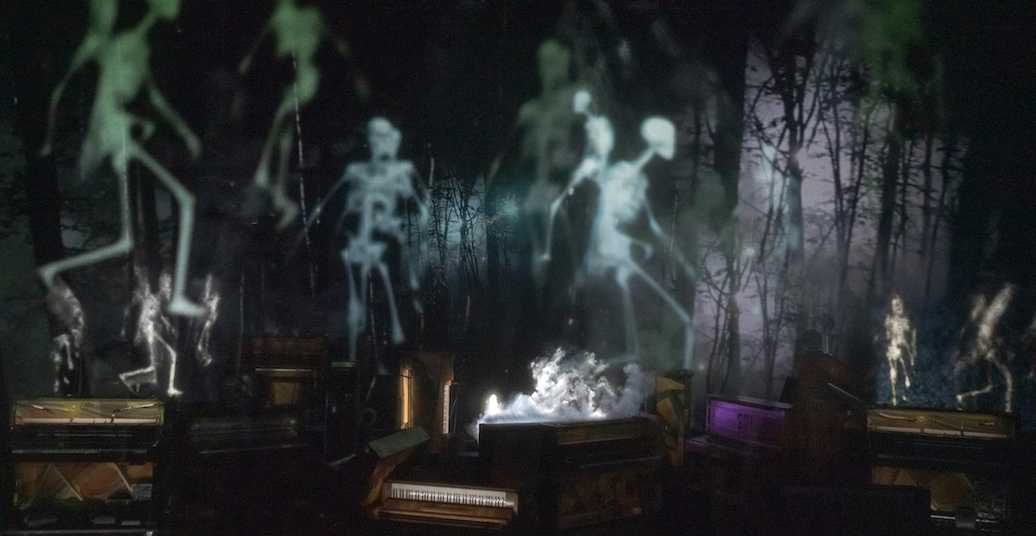Philippe Quesne’s “Fantasmagoria”, in its German premiere at HAU2 on 2 and 3 March 2023, looks at new materialism through the theatrical lens of eighteenth-century storytelling and scientific experimentation, searching for a vital spark.
A voice whispers with the intensity of a Gothic narrator relating horrors by candlelight: a new liquid that animates lifeless objects…Swarming over the closed curtains, a flock of projected pale objects swirls nearer until they are recognizable as human bones. Some eventually come together into a skeleton; the rest arc across the top of the closed curtain to spell out FANTASMAGORIA. What we are about to see, the whispering voice says, is not a mere spectacle. We will encounter magic, spells, terror, the occult. We’re going to be asked to think.
The curtain opens on a piano graveyard, moving and twitching, invisibly animated. Smoke begins to emanate from the instruments, swirling up like oil on water. A piano rises towards the rigging. Rings of light appear in the smoke, more skeletons falling through them. They are projected moving images but the rising fog onto which the light falls, making the images visible, also gives them dimensionality and blurs their borders so that they seem to melt, disintegrate, and re-form. Text is alternately whispered, softly spoken, and sung, in different voices; it poses questions about the source of life and the meaning of death, about spirits and what their existence might be like, about the link between materiality and vitality. Onstage, we find ourselves in a forest: projections of trees surround the wood-and-string pianos, with flashes of light among them that now seem to be fireworks, now a forest fire. The disembodied voice now asks questions about civilization and happiness, superfluity versus necessity. I wonder, are these trees the ancestors of the toppled pianos, these heavy elders of the classical and Romantic music that accompanied Enlightenment-era Europe? We seem to hover between a wilderness lost and a civilization in its death throes. And throughout, the skeletons (or are they, at times, spirits?) circulate, from projection screen to fog surface, spirit to material world. I slip into a dreamy state.
The show notes explicitly call “Fantasmagoria” a laterna magica, an early type of image projector whose use became widespread in the 1700s by storytellers and popularizers of science. With its motley collection of instruments and speakers, its flame and water, it’s also a Wunderkammer—a cabinet of curiosities, a private collection of objects that originated in the Renaissance period and contained a diverse array of natural and man-made objects, scientific specimens, and cultural artifacts that were meant to evoke a sense of wonder and curiosity about the world. Quesne’s tools and themes—fear, the grotesque and macabre, spectacle and illusion—are taken directly from these eighteenth-century forms that hovered between popular entertainment, scientific experiment, lecture, morality play, and vanity project. The text that accompanies the performance conjures eighteenth-century science and philosophy. Galvanism was a real early theory of electricity that partially inspired Mary Shelley’s Frankenstein. And vitalism, which held that living organisms are fundamentally different from non-living matter and that they possess a special “vital force” that cannot be reduced to physical or chemical processes, was a philosophical heavyweight that held its own throughout the Enlightenment against chemistry and mechanistic explanations of life.
As much as it draws on these old tools, Quesne’s theatre without actors is embedded in a very different contemporary performance discourse, shaped by posthumanism and object-oriented ontology, actor-network theory and new ecological dramaturgies. Vitalism has been picked up and reshaped in recent years by, among others, Jane Bennett in her foundational 2010 book Vital Materialism, in which she develops a theory that recognizes the agency and vitality of matter to help us better understand and address contemporary ecological and political challenges. How does Quesne’s laterna magica fit into this new landscape?
Geysers of flame interrupt my reverie. They shoot up between the pianos, and I can feel the heat on my cheeks; the forest is gone. After the fires stop, the stage looks suddenly more like a dusty garage than a Wunderkammer. A song plays from a speaker onstage, and some of the pianos play along, their keys depressing under no hand. A single piano flies up, dances above all the rest, moving and twirling across the stage.
The hour-long performance is an impressive choreography of objects and elements. Quesne builds an ingenious mechanism in which objects, light, water and water vapor, fire, and sound are the players, and these players do indeed play off one another in ways that at times gives rise to lively moments among so-called inanimate objects. But Quesne’s machine is so tightly controlled that these moments remain manmade illusions, much like the experiments demonstrating galvanism that ran electrical currents through frog legs and corpses, only seeming to reanimate them. These are sixty entertaining and often surprising minutes that provide a pleasant container for contemplating new materialism, but ultimately they feel a bit lifeless, a reminder that minds and performance traditions still haunted by the spirits of Enlightenment ideas and mechanistic science have no idea yet how to be real co-actors alongside the more-than-human.
“Fantasmagoria” by Philippe Quesne is shown once more today, on 3 March 2023 at 7pm at HAU Hebbel am Ufer (HAU2).
The event is part of the festival Spirits, Jinns & Avatars – On Magic in the Digital Age (2.–12.3.2023 / HAU1, HAU2, HAU3, HAU4). You find the full program and ticket info at hebbel-am-ufer.de.




